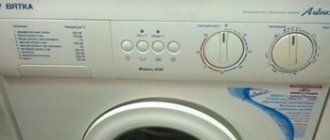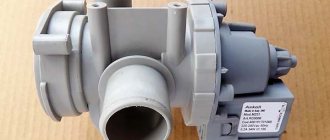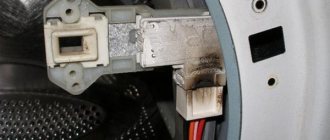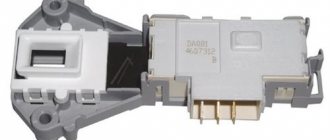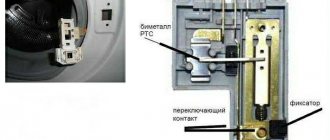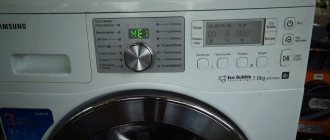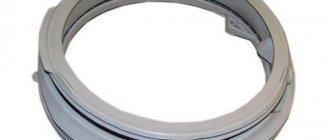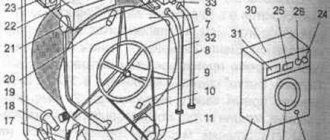In the event of a breakdown of household appliances, you can easily call a competent specialist. But can he always deal with problems competently, and won’t he fraudulently force you to pay for expensive repairs? That is why it is better to know how to independently diagnose a washing machine: this will help save your time and money.
Sources of problems
In a situation where your household appliance indicates any error or malfunction, you must refer to the instructions. It briefly summarizes the most common breakdowns and parts subject to wear for this model.
In addition, the self-diagnosis function is common among modern models. For example, the Smart Diagnosis system is integrated into devices from LG , which allows you to determine a malfunction without any special technical knowledge. If your machine is not equipped with such know-how, then it is quite possible to conduct a visual inspection and identify problems. Some of them do not require professional repairs, but are caused by a simple failure to comply with the rules for operating the device.
Before starting inspection or repair, make sure that the machine is disconnected from the network and water supply.
What is self-diagnosis in a washing machine
Also called “smart diagnostics,” this function is present in many modern washing machines in the middle and high price segment. Most often, manufacturers of such equipment do not forget to highlight this useful option by additionally placing the Smart diagnosis inscription on the body.
Reference. Very often, this option is found in models from the manufacturer LG.
Using this function, the “smart” SMA electronics are able to recognize up to 85 different faults and, using the owner’s smartphone, transmit information about a particular breakdown to specialists in the service center. If possible, the user is asked to fix the problem himself (for example, close a poorly fitting loading hatch more tightly).
The car won't start
One of the most popular problems that can happen to your car during operation. But don’t panic, the reason for failure to start may not only be a system malfunction. For example, the program may not start for the following reasons:
- Lack of electricity - make sure that the socket for connecting to the network is working properly, check the operation of the switchboard and the integrity of the washing machine wire.
- There is a problem with the start button - the contacts may have oxidized or the button itself may have suffered a critical breakdown. Check it for damage
- The lid is not tightly closed or the hatch is not locked - make sure the loading hatch is tight. The washing program will not start if the special sensor does not receive a signal to close the lid.
- Noise filter problem - Most machines have a device installed right behind the power cord to filter electrical noise. When it fails, it simply blocks access to electricity, preventing the device from turning on. Check how functional it is.
- The electronic control module, the so-called “brain” of the household appliance, is damaged. If it fails, then you cannot do without professional repairs; in this case, you will have to call a specialist.
Where to begin
First, we diagnose the operating condition of the washing machine.
Machines with a microcontroller may not perform well due to errors in the service codes.
Decryption can be quickly done according to the instructions, or you can find out the algorithm of actions on the Internet.
Please note: most often breakdowns occur in the drainage system or in the drying device.
It is more difficult to repair washing machines with partially mechanical controls, but this can be done if you strictly follow the instructions.
Causes of drum problems
Problems with the machine drum can be very diverse, from the breakdown of the main engine to the failure of seemingly insignificant parts.
Complete drum stop
A breakdown in the motor means absolutely no sounds will be heard. Such a stop of the drum may indicate engine combustion. Check its windings to make sure they are not damaged.
The heating element has failed - the reason for the failure to work may also be a failed heating element. Usually, when this breakdown occurs, the machine issues a special signal to the control panel.
Malfunctions in the electronic control module are the main controlling element, without which not a single program can be launched. The machine will not respond to button presses. To repair your module, you will have to contact a specialist.
Failure of the heating element
The drum stands still, but the hum of the engine is heard
A foreign object could get into the space between the drum and the tank: small change forgotten in pockets could jam the rotating elements. This situation can be resolved by removing the heating element and removing unnecessary objects.
Failure of the electric motor - a rupture or burnout of the motor windings leads to a loss of power, and it simply cannot move the loaded drum. Check their integrity.
Worn brushes in the motor are a typical problem with household appliances. The most wearing part of the engine - brushes - require periodic replacement.
Jamming of the bearing system - this happens with worn bearings. This problem can only be resolved by completely disassembling the household appliance.
A broken electronic control module is one of the most serious breakdowns. It can be eliminated only by reprogramming the module or replacing it with a new one. This type of repair is best left to the professionals. Since the procedure requires special knowledge.
Replacing washing machine motor brushes
Idle motor operation without drum rotation
Broken drive belt – In indirect drive machines, problems with belts quite often occur. It's worth checking its condition. This can be done by removing the back panel.
The pulley slack is the part that attaches to the drum and connects it to the belt. After using the machine for a long time, the pulley begins to rotate in place without rotating the drum.
The drum rotates in one direction only.
Here the problem lies in the electronic control module. Problems can disrupt its operation and disrupt the rotation algorithm. In some machines, this function is performed by special boards. They can also malfunction or even burn out. Check their functionality and replace with new ones if necessary.
Doesn't turn on - control panel doesn't light up
It happens quite often that after power surges the control panel and/or indicators do not light up. With a high degree of probability, this means that the central control board has failed. Such modules are quite easy to repair if you understand electronics. All washing machines are equipped with control modules with switching power supplies.
Control module
The most common cause of control module failure is failure of capacitors in the cold circuit. A burnt capacitor can be easily detected by swelling of the upper surface.
Capacitor
If such swelling is detected, the capacitor simply needs to be replaced with a working one. Troubleshooting the board in a washing machine is best done only if you are 100% sure of the result.
If the washing machine does not turn on at all, then the cause may be a burnt-out power filter. This is not the filter with a glowing button and many sockets, but a device that blocks interference from the washing machine - FPS (anti-interference network filter).
Network filter
It is checked simply; the tester rings the contacts at the input and output. If there is no contact, the FPS needs to be replaced with a new one.
There is one trick. If it is not possible to buy and install an FPS, you can connect the contacts that go directly to it. In this case, the washing machine will work without problems. But then, when washing, it is better to turn off thin electronics in the apartment: computers, televisions, etc. Since the washing machine will already create interference in the electrical network.
Bypass FPS (Not recommended)
The reason for the malfunction of the washing machine electronics is poor quality of electricity - voltage surges. Despite the widespread belief that connecting a washing machine to a separate RCD can protect it, this is not the case. The only reliable protection is to connect the device through a switching voltage stabilizer. If it is not there, then after washing, simply remove the power cord and sockets.
Unpleasant noise
After some time has passed since the date of purchase, the machine may begin to make strange sounds. There are several reasons for this.
- Foreign bodies, garbage, coins, forgotten in clothing pockets - all this can create strange sounds. Check the distance from the tank to the drum: foreign objects may have gotten there.
- Problems with the water drainage system or pump malfunction. Inspect the pump.
- Failed bearing system. Carefully inspect the bearings and check their level of wear.
- Incorrect position of the machine. Read the instructions for installing and adjusting the machine. Try twisting the legs to different heights.
All these problems require a careful examination of the internal parts of the machine, and sometimes calling a technician.
Replacing bearings
The machine makes noise and vibrates
It is not uncommon to encounter a situation where the washing machine literally starts jumping around the bathroom or vibrating. It also happens that the washing machine hums during the spin cycle and begins to make strange sounds during operation. This may be due to the following reasons, which you can diagnose yourself:
- Incorrect installation of the washing machine is the most common reason that the machine vibrates during washing and especially spinning. Check that the machine is level.
- The transport bolts are not unscrewed - if you have just bought a washing machine and installed it, check that the transport bolts located on the back wall have been unscrewed. If they are not removed, the machine will literally jump and will soon become unusable.
- Imbalance - check that the laundry is evenly distributed throughout the drum. If it lies in one lump, then vibrations are possible during the spin cycle.
- Worn bearings – If you hear a noise that occurs while the drum is spinning, then there is a good chance that the bearings in your washing machine are worn out. In order to change them, you need to completely disassemble the washing machine.
- The counterweight is weakened - perhaps one of the counterweights, which are attached to the tank to weigh down the structure and dampen vibrations, has become loose and is knocking while the washing machine is operating. Check the counterweight mountings.
- Wear of springs or shock absorbers - perhaps one of the springs on which the tank hangs has stretched or even burst. It is also possible that the shock absorbers no longer perform their function and they have a lot of play. For such reasons, the tank begins to knock against the walls of the washing machine. Check and replace faulty parts.
- The drive belt has stretched - when the belt stretches, the machine begins to “whistle”; if you hear such a whistle, then the belt has probably stretched and it’s time to replace it.
- The fastenings of parts or the housing are loose - it is possible that the engine mounts are loose, other parts and even the fastenings of the housing walls themselves may also become unscrewed. As a result, you will hear knocking and noise during washing. Check and tighten any loose bolts.
Spin function not performing
The laundry may not be spun for a number of reasons, ranging from software failures to mechanical damage. Let's look at the most common of them.
- The wrong program is running. Check which program you have launched; not all washing algorithms include spinning. Read the instructions and enable the correct algorithm.
- Drum overload. If you have not calculated the weight of the laundry and have loaded more into the drum than is provided by the design, the spin mode will not start until the overload is eliminated. Also in modern models a balance sensor can be installed. Unevenly distributed laundry creates an imbalance in the drum and prevents the spin cycle from starting.
- Failure in the drainage system. The spin system will start only after the dirty water has been removed from the drum. Check the drain pump and pipes for blockages and kinks.
- Problems with the tachometer. This is a special device that controls the number of drum revolutions. It is installed on the shaft of the washing machine, and fails when the household appliance is frequently used to its maximum capacity. Check the fastening and wiring of the tachometer. Make sure the contacts are intact.
As you can see, diagnosing a washing machine with your own hands is not something scary or difficult; anyone can learn how to do it. With proper care and timely replacement of parts, your household appliance will never let you down.
Online diagnostics of washing machine faults
Absolutely all washing machines, regardless of brand or manufacturer, work on the same principle:
Washing consists of four stages:
1. Soaking; 2. Washing (30-40% of program time); 3. Rinse; 4. Spin (8-10% of time); 5. Drain (after each washing stage).
First you need to diagnose the washing machine yourself . Modern models of washing machines are equipped with self-diagnosis systems, for example Smart Diagnosis (LG), which allows you to determine a breakdown without additional knowledge. But even if your washing machine does not have such a system, you can still diagnose it yourself.
If your washing machine displays an error code or you notice a malfunction in its operation :
Just select a problem from the list and find out the approximate breakdown
"Freezes"
Is your washing machine freezing? The main reasons may be:
The problems in which the washing machine freezes are huge and can be associated with almost any component. Most often this is: 5% probability 1. Overloading of the washing machine; probability 5% 2. Water stop mode; probability 5% 3. Linen imbalance; probability 5% 4. Foreign body getting between the tank and the drum; probability 5% 5. Failure of the washing machine motor; probability 75% 6. Control module malfunction.
Departure and diagnostics 1000 rub.!
The drum is dangling
Is your washing machine drum loose? The main reasons may be:
probability 50% 1. Damage to shock absorbers; probability 40% 2. Wear and destruction of bearings and oil seal; probability 5% 3. The cross shaft wears out or is destroyed; probability 5% 4. The spring flew off, bent or burst.
Departure and diagnostics 1000 rub.!
Electric shock or sparks
Is your washing machine electrocuted or sparking? The main reasons may be:
probability 15% 1. Incorrect connection to the washing machine; probability 60% 2. Fault in the electrical wiring of the washing machine; probability 5% 3. Breakdown of the electric motor or heating element (heater); probability 5% 4. Lack of grounding; probability 5% 5. Worn brushes of the electric motor of the washing machine; probability 5% 6. The lamellas of the washing machine motor commutator are broken; probability 5% 7. Dampness in the room.
Departure and diagnostics 1000 rub.!
It takes on water all the time
Is your washing machine constantly filling with water? The main reasons may be:
probability 20% 1. The new washing machine is not connected correctly; probability 20% 2. The washing machine tank is leaky; probability 20% 3. The water level sensor has failed; 20% probability 4. Intake valve malfunction; probability 20% 5. Problem with the electronic control unit.
Departure and diagnostics 1000 rub.!
Knocks out traffic jams (automatic)
Does your washing machine knock out plugs (automatic machines) when washing? The main reasons may be:
probability 5% 1. Short circuit, faulty socket, or short circuit in the washing machine; 2. Old electrical wiring, an inappropriate automatic circuit breaker (RCD) is installed, or the washing machine is incorrectly connected to the electrical network;
probability 5% 3. The load on the electrical network is too high, it is necessary to reduce the load (turn off some electrical appliances in the house);
probability 5% 4. The on/off button is shorted, the surge protector is faulty;
probability 5% 5. The control module of the washing machine is faulty;
probability 40% 6. Malfunction of the heating element (heater); 7. Malfunction of the washing machine motor;
probability 40% 8. Water leaking onto the electrical equipment of the washing machine.
Departure and diagnostics 1000 rub.!
Sewage smell
Does your washing machine smell like sewage? The main reasons may be:
probability 70% 1. Violation of the rules in connecting the drain hose to the sewer system; probability 15% 2. Frequent washing in an economical mode, with short rinsing and low temperature; probability 5% 3. There is a large amount of scale on the heating element (heater); probability 10% 4. The drain pump filter has not been cleaned for a long time.
Departure and diagnostics 1000 rub.!
Foreign object sound
Do you hear a foreign object sound in your washing machine during washing? The main reasons may be:
probability 100% 1. Small things (solid elements of bras, jewelry, fasteners) often get into the gap between the tank and the drum; 2. If you hear a clanging sound while the machine is running, as if metal is rubbing against metal, a foreign object may have gotten under the drum; a metallic sound may also indicate wear or malfunction of parts; 3. Even objects such as a handkerchief or sock caught inside the machine can block the drain pump or prevent it from rotating.
Important! If you ignore this fact, the following problems may arise: Mechanical damage to parts of the washing machine. At high rotation speeds, the solid element acquires enormous force - it can easily pierce the walls of the drum and disrupt the integrity of the tank or heating element. We will have to repair damaged elements and fight the flood. Damage to the rubber seal around the hatch. Rotation lock. Even if it does not interfere, a small metal part stuck somewhere in the depths of the machine will begin to rust over time and begin to stain clothes washed in the machine. The drum may also jam, in which case disassembling the tank is inevitable. Removing a foreign object is comparable in complexity to replacing a bearing. And if the tank is not collapsible, you will have to saw its body. This task takes several hours and requires special skills and tools.
Departure and diagnostics 1000 rub.!
All indicators are flashing
Are all the lights on your washing machine blinking? The main reasons may be:
probability 80% 1. If the washing machine does not work, the red lights are on or the indicators of all buttons are on, most likely the cause is a malfunction of the control module; probability 5% 2. Perhaps you or someone else accidentally turned on the child lock; probability 5% 3. Failure of the heating element (drying or heating); probability 5% 4. Drain pump failure; probability 5% 5. Electric motor malfunction.
Departure and diagnostics 1000 rub.!
Doesn't turn on
Your washing machine won't turn on? The main reasons may be:
probability 25% 1. Control module malfunction; probability 10% 2. Incorrect connection to the network, check the functionality of the socket; probability 20% 3. The washing machine power cable is damaged; probability 10% 4. The locking system for the laundry loading hatch is out of order; probability 20% 5. Network filter malfunction; probability 15% 6. The power button is faulty.
Departure and diagnostics 1000 rub.!
The drum does not rotate
Is your washing machine drum not spinning? The main reasons may be:
probability 40% 1. The drive belt has worn out or jumped off; probability 40% 2. Damage to the electric motor; probability 15% 3. Bearing wear or damage; probability 5% 4. Control module malfunction.
Departure and diagnostics 1000 rub.!
Doesn't turn off
Your washing machine won't turn off or stop? The main reasons may be:
probability 25% 1. Control module malfunction; probability 25% 2. Incorrect connection to the sewerage system; probability 25% 3. The heating element (heater) has failed; probability 25% 4. Problems with the filter and drain hose.
Departure and diagnostics 1000 rub.!
Doesn't heat water
Is your washing machine not heating the water? The main reasons may be:
probability 5% 1. Incorrect connection of the washing machine (the water in the tank simply does not have time to heat up to the required temperature, since warm water is constantly drained into the sewer and a new cold portion of water is automatically added); probability 5% 2. Wrong choice of washing program; probability 5% 3. Oxidation of heating element (heater) contacts; probability 60% 4. The heating element (heater) has burned out; probability 15% 5. Malfunction of the temperature sensor (thermostat); probability 10% 6. The control module (programmer) is faulty.
Departure and diagnostics 1000 rub.!
Doesn't close
Does your washing machine have a door that won't close? The main reasons may be:
probability 40% 1. The hatch lock is out of order; probability 30% 2. The handle of the laundry loading hatch is broken; probability 20% 3. Malfunction of the hatch locking device; probability 10% 4. Control module malfunction.
Departure and diagnostics 1000 rub.!
Water does not fill
Does your washing machine not fill with water when you start washing? The main reasons may be:
probability 35% 1. Water level sensor malfunction; probability 20% 2. The control module has failed; probability 30% 3. Blockage in the water supply system; probability 10% 4. Malfunction of the water filling system; probability 5% 5. No cold water.
Departure and diagnostics 1000 rub.!
Doesn't wring out
Is your washing machine not spinning clothes? The main reasons may be:
probability 40% 1. Worn or broken drive belt; probability 40% 2. The electric motor has failed; probability 15% 3. Wear of the bearing unit; probability 5% 4. Control module malfunction.
Departure and diagnostics 1000 rub.!
Sunroof won't open
Does your washing machine have a door that won't open? The main reasons may be:
probability 40% 1. The hatch lock is out of order; probability 30% 2. The hatch handle is broken; probability 20% 3. Malfunction of the electrical circuit of the hatch locking device; probability 10% 4. Control module malfunction.
Departure and diagnostics 1000 rub.!
Doesn't rinse
Is your washing machine not rinsing (not going into rinse mode)? The main reasons may be:
probability 75% 1. Control unit malfunction; probability 5% 2. Insufficient water pressure in the water supply; probability 5% 3. Blockage in the pump, drain filter or pipe; probability 5% 4. Water level sensor malfunction; probability 5% 5. Drain pump malfunction; probability 5% 6. Malfunction of the heating element (heater).
Departure and diagnostics 1000 rub.!
Programs do not work (all or partially)
Are the programs not working in your washing machine (all or partially)? The main reasons may be:
80% probability 1. Control unit malfunction; probability 5% 2. Malfunction of the heating element (heater); probability 5% 3. Electric motor malfunction.
Departure and diagnostics 1000 rub.!
Doesn't drain water
Is your washing machine not draining water? The main reasons may be:
probability 60% 1. Drain pump malfunction; probability 35% 2. Clogged drain system; probability 5% 3. Control module malfunction.
Departure and diagnostics 1000 rub.!
Doesn't wash off powder
After rinsing, the washing machine does not wash away the powder? The main reasons may be:
probability 30% 1. The water inlet valve is faulty or clogged; probability 30% 2. Malfunction in the mechanism for supplying water to the detergent tray; probability 40% 3. The dispenser compartments are mixed up.
Departure and diagnostics 1000 rub.!
Stops during the washing process
Does your washing machine stop during the wash cycle? The main reasons may be:
probability 20% 1. Wrong washing mode; probability 20% 2. There is too much laundry in the drum, or you put it incorrectly; probability 20% 3. Leakage protection has activated; probability 20% 4. Malfunction of the electric motor, drain pump or heating element (heater); probability 20% 5. Problem with the control unit.
Departure and diagnostics 1000 rub.!
Scale has appeared
Has your washing machine developed limescale? The main reasons may be:
probability 80% 1. Poor water quality and increased hardness; probability 20% 2. Repeated washing at temperatures above 75 degrees.
Departure and diagnostics 1000 rub.!
Spots have appeared
Are there stains on your laundry after washing? The main reasons may be:
probability 10% 1. Drum overload; probability 30% 2. Low water pressure; probability 10% 3. Use of Calgon (can settle on laundry and lead to yellow stains); probability 20% 4. Violation of the dosage of chlorine-containing products; probability 30% 5. Incorrect amount of powder.
Departure and diagnostics 1000 rub.!
Tears underwear
Damaged laundry after washing in the washing machine? The main reasons may be:
probability 70% 1. Foreign objects falling out of clothing or otherwise entering the drum; probability 15% 2. Bearing failure; probability 10% 3. Sharp edges and burrs inside the drum; probability 5% 4. Incorrect washing mode.
Departure and diagnostics 1000 rub.!
Creaks
Does your washing machine squeak during operation? The main reasons may be:
probability 60% 1. Faulty bearing unit; probability 10% 2. The drive belt is stretched; probability 20% 3. Wear of springs and shock absorbers; probability 10% 4. Shaft weakening; probability 10% 5. Foreign objects in the drum.
Departure and diagnostics 1000 rub.!
The wash does not stop (endless wash)
Is your washing machine not stopping? The main reasons may be:
probability 5% 1. Problems with water intake and drainage; probability 5% 2. Incorrect connection to the sewer; probability 5% 3. Clogged filters and hoses; probability 5% 4. Incorrect operation of the water level sensor; probability 5% 5. Intake valve failure; probability 5% 6. Thermostat malfunction; probability 70% 7. Control module malfunction.
Departure and diagnostics 1000 rub.!
Knocks when spinning or washing
Does your washing machine make noise when spinning or washing? The main reasons may be:
probability 15% 1. Incorrect installation of the washing machine; probability 15% 2. Uneven distribution of things in the drum; probability 50% 3. Shock absorber failure; probability 10% 4. Broken spring; probability 10% 5. Problem with the drum counterweight.
Departure and diagnostics 1000 rub.!
Water flows (large puddle)
Is your washing machine leaking (too much water)? The main reasons may be:
probability 55% 1. The water supply pipe has come off; probability 25% 2. One of the pipes has broken; probability 20% 3. Blockage in the water supply and drainage system.
Departure and diagnostics 1000 rub.!
Water flowing (small puddle)
Is your washing machine leaking (small puddle leaking)? The main reasons may be:
probability 15% 1. Damage to the hatch cuff; probability 20% 2. One of the pipes has broken; probability 30% 3. Blockage in the water supply and drainage system; probability 10% 4. Leak in the dispenser hopper; probability 25% 5. The water supply pipe has come off.
Departure and diagnostics 1000 rub.!
Noise and vibration
Does your washing machine make a lot of noise and vibration? The main reasons may be:
probability 30% 1. Wear of the bearing unit; probability 30% 2. Shock absorbers are out of order; probability 30% 3. The counterweight has moved or is poorly secured; probability 10% 4. Incorrect installation of the washing machine relative to the floor.
Departure and diagnostics 1000 rub.!
Attention! If you could not determine the breakdown and the cause, do not disassemble the device.
The washing machine runs on 220 V , add to this high humidity and the presence of water , this is life-threatening !
Found the cause but couldn't fix the problem? Or the reason is not clear! Feel free to call a specialist!
How to call a technician to your home?
Leave a repair request in the form. The technician will arrive at a time convenient for you, repair the washing machine and issue a warranty!
Leave a request for repairs
or call:
8 (985) 181 – 02 – 88
8 (985) 181 – 02 – 88 (Whatsapp)
Washing machine repair prices
Attention! The prices indicated on the website do not include the cost of spare parts. The exact repair price depends on the breakdown and the cost of spare parts for your washing machine model. All types of work are guaranteed and a certificate of completion of work is issued on a special form. The final cost of repairs is determined after diagnosis.
| Name of service | Cost of the master’s work*, rub. | Guarantee |
| Expert visit, fault diagnosis | 1000* | — |
| Dismantling or installation of built-in equipment | from 600 | — |
| Simple repair | ||
| Opening the hatch without repair | from 1250 | — |
| Replacing the hatch handle | from 1300 | 6 months |
| Sunroof glass replacement | from 1300 | 6 months |
| Replacing the hatch | from 1250 | 1 year |
| Replacing the door hinge | from 1250 | 6 months |
| Replacing a button | from 1250 | 6 months |
| Replacing the surge protector | from 1400 | 12 months |
| Replacing the drain hose | from 1250 | 2 years |
| Replacing the inlet hose | from 1250 | 1 year |
| Replacing the drain filter | from 1300 | 1 year |
| Replacing the detergent dispenser | from 1250 | 2 years |
| Cleaning the drain filter | from 1250 | — |
| Cleaning the filler filter | from 1250 | — |
| Replacing the drive belt | from 1250 | 1 year |
| Removing shipping bolts | from 1250 | — |
| Finding and removing blockages in the drain system (without disassembly) | from 1250 | — |
| Repair of the dispenser hopper | from 1250 | — |
| Repair, sealing, elimination of pipe leaks | from 1250 | — |
| Removing foreign objects (without disassembly) | from 1250 | — |
| Medium renovation | ||
| Finding and clearing blockages in the drain system (partial disassembly) | from 1250 | — |
| Removing foreign objects (with disassembly) | from 2800 | — |
| Replacing the hatch locking device | from 1300 | 1 year |
| Replacing motor brushes | from 1400 | 6 months |
| Replacing the fill valve | from 1500 | 6 months |
| Replacing the temperature sensor | from 1300 | 6 months |
| Replacing the heating element | from 1400 | 6 months |
| Replacing shock absorbers | from 2100 | 1 year |
| Replacing springs | from 1900 | 1 year |
| Replacing the water level sensor | from 1600 | 6 months |
| Replacing the drying heating element | from 1600 | 6 months |
| Replacing the hatch cuff | from 1600 | 1 year |
| Replacing the drain pump | from 1600 | 6 months |
| Replacing the drum pulley | from 1600 | 1 year |
| Replacing the drying motor | from 1800 | 6 months |
| Replacing the wiring harness | from 1500 | 2 years |
| Replacement of drum curtains, without disassembly (vertical loading) | from 1900 | 6 months |
| Replacing the upper counterweight | from 1800 | 2 years |
| Replacing the circulation pump | from 2000 | 6 months |
| Replacing the control module or display unit | from 2000 | 1 year |
| Replacing the programmer | from 2000 | 6 months |
| Engine repair or replacement | from 2000 | 1 year |
| Repair of the control module or display unit | from 2500 | 6 months |
| Repair and replacement of aquastop | from 2000 | 1 year |
| Repair and replacement of pipe | from 1500 | 2 years |
| Complex repair | ||
| Disassembling the tank | from 1500 | — |
| Replacing bearings and oil seal | from 3300 | 1 year |
| Replacing the tank or drum | from 3500 | 2 years |
| Replacing the tank support | from 3300 | 1 year |
| Replacing the crosspiece, drum ribs | from 2900 | 2 years |
| Replacing drum curtains, with disassembly (vertical loading) | from 2900 | 6 months |
| Replacing the lower counterweight | from 3500 | 2 years |
| Additional services | ||
| Diagnosis of malfunctions of a machine disassembled by the owner | 2000 | — |
| Connecting the machine to water supply and sewerage using ready-made communications | from 1000 | 1 year |
| Delivery of spare parts | 500 | — |
| Delivery of large-sized spare parts | 800 | — |
| Delivery of equipment to/from the workshop | 1000 | — |
| Washing machine maintenance | from 1200 | 1 year |
| Washing machine overhaul | from 6500 | 1 year |
| Disposal of the machine | 2000 | — |
| *The indicated prices are for repair work (excluding the cost of spare parts and components), spare parts and components are paid additionally. *There are no free services, a technician’s visit and diagnostics cost RUB 1,000. If you agree to repair, there is no charge for travel and diagnostics. False call, payment 1000 rub. The final cost of repairs depends on the complexity of the work and the cost of spare parts, components and materials. | ||
Washing machine operating instructions
Washing machine error codes
Washing machines from manufacturers that we repair
What can you do on your own?
Are you wondering whether to repair a worn-out device or get a new one? Immediately decide on it:
- price,
- functionality,
- appearance,
- noise level,
- factory warranty;
- and with diagnostic secrets.
Then the right decision will be made. After all, if you carry out this procedure correctly and on time, you may not even end up with a breakdown. Should I call a professional? This is everyone’s business, a lot depends on the financial situation as well. The main thing is that you can do a lot on your own.
The huge number of washing machines implies, of course, significant differences in their design, even if they were made by the same manufacturer.
Some models will have the same parts, while others will have nothing in common. Since such differences and nuances in designs and models are encountered all the time, do-it-yourself diagnostics become somewhat more complicated. Although it is still possible.
Diagnostics by phone?
Yes, smart washing machine diagnostics is a real new feature of LG Smart Diagnosis. In this situation, remote automatic diagnostics of washing machines of this brand is carried out. That is, you don’t need to call a service specialist or try to bring your “white” friend back to his senses. If there is a device in the house with such a function, its owner, or more precisely, the machine itself, will only have to “tell” the service center employee over the phone what is bothering it. You only need to do one thing - call support, where they will tell you which buttons you need to click on the control panel of the device, and then bring your mobile phone to the speaker. After the washing machine issues certain signals, the diagnostics of the LG machine will begin as such: the technician will instantly understand what happened and decode the signal using special equipment. In the future, it may even be possible for the user to fix the device themselves thanks to instructions from a service center instructor. And the called specialist, if it comes to this, will complete all the work more quickly.

